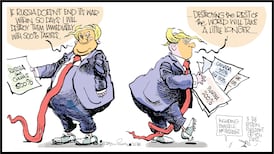EVERY CLOUD has a silver lining, as we all know. And so it was with the otherwise-alarming news that the Irish taxpayer has picked up €1 billion in loans formerly owned by the property tycoons Johnny Ronan and Richard Barrett. Which at least reminded me about one of my own investments whose value may still be increasing: namely, a small vinyl record collection.
The link was Battersea power station: the brick-built London monolith that a Barrett/Ronan-backed company bought for €600 million in 2006 at the height of the boom.
As chance would have it, this same building featured on the cover of the first album I ever bought: Pink Floyd's 1978 collection, Animals. By contrast with the actual power station, the record cost a modest £3.86. But it's all relative. I was an impoverished 15-year-old at the time, so you can be sure that the investment was heavily leveraged.
Like the five other records that comprise my collection, Animalsis in pristine condition, having been played only once. This is not because of a shrewd realisation that, after a period of apparent obsolescence, vinyl would one day start appreciating again. No. It was mainly because, while I could afford to buy the odd record back then, I couldn't afford a record player.
What I did have was a small cassette-deck, whose even smaller powers of musical reproduction had somehow survived its fall off the back of a lorry. I also had a friend with a state-of-the art “music centre”, who would illegally download (as we didn’t call it) my records onto blank tapes, so that I could actually listen to them.
Why did I not just buy the albums on tape, you may ask? Well, because a record could be a thing of beauty in those days. Not the grooved black plastic bit itself, so much (although the aesthetic pleasures of polyvinyl chloride are now belatedly appreciated). But the album sleeves were often works of art. And Pink Floyd in particular put of a lot of thought into them.
The gatefold cover of Animalsset the tone for the gloomy music inside. I barely realised then that it was a real building, never mind that it was the biggest brick structure in Europe and an Art Deco classic. It looked instead like something that band's graphic designers had dreamed up to represent the industrialised dystopia suggested by the music. Whereas in fact, it was a faithful reproduction of the power station, with the addition of a giant inflatable pig that loomed overhead, between the chimneys, and which would become the star prop of the band's subsequent concert appearances.
Although the album's concept clearly owed much to Orwell's Animal Farm, which was a satire on Stalinist communism, Roger Waters's lyrics seem to have been an attack on the excesses of 1970s capitalism. Which, in the context of what has happened to Battersea Power Station in more recent times, now seems very prescient.
Not that, even in his most disturbing visions of the future, Waters could ever have imagined that a bunch of Paddies would one day buy the place for half a billion quid. And as for his Irish listeners, we could reasonably have expected, circa 1978, that actual pigs might fly before we would ever be financially implicated in a such a deal. Yet somehow this has come to pass.
My first question about the latest Nama bailout was whether, as a taxpayer, I now had shares in the power station. If so, it would be an interesting addition to my investment portfolio, completing a kind of set with the album. And to be honest, I’m still not fully clear on this issue.
A €100 million loan that went towards Battersea’s purchase is now partly mine, I gather. On the other hand, I note that the purchasers plan to “float off the Battersea project” to a separate company later this year, and nobody has thought fit to consult me about this yet.
At the very least it seems clear that I now have a vested interest in the success of Battersea’s development. And as such I’m a little bit worried about this “float-off” plan, which one hopes will more controlled than the one Pink Floyd oversaw while designing the album cover.
For the original photoshoot, the band commissioned a 40ft long plastic pig (from the German company that built the zeppelins), which was to be inflated with helium and tethered from one of the power station’s giant chimneys. When the day came, a professional marksman was on stand-by to bring the balloon down in case of problems.
Unfortunately, the shoot (photographic) dragged into a second day because of wind conditions and somebody forgot to rehire the shooter (ballistic). Then, sure enough, the pig was torn loose from its moorings and floated across London airspace, forcing the Civil Aviation Authority to warn pilots. It eventually landed on farmland in Kent, safely (apart from traumatising some cows). Even so, it’s not a reassuring precedent.











